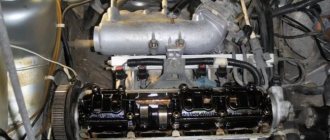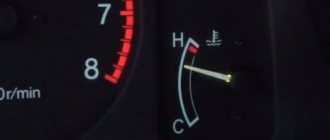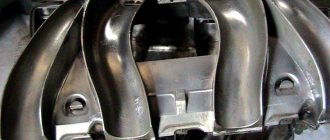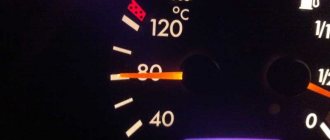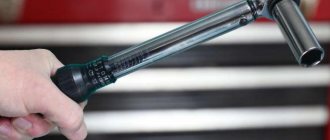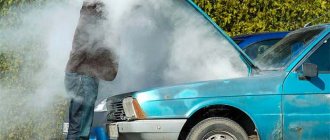What affects the condition of the collector
The temperature of the gases leaving the cylinder head exceeds 600 degrees.
If the engine is operating at maximum power, the ignition timing is incorrectly set, or the fuel system is preparing a mixture that is too rich or lean, then the temperature of the exhaust gases exceeds 1500 degrees. Because of this, the exhaust manifold heats up to a temperature of 200–300 degrees. In maximum power mode, if the ignition or fuel preparation systems are not operating properly, its temperature can reach 600 degrees, which is why the collector acquires a dull crimson color. If all engine systems operate normally, the service life of the exhaust manifold exceeds 40 years. The exception is racing cars and cars whose engines are constantly running at maximum power. The passage of hot gases leads to gradual burnout of the metal. The burnout rate is affected by:
The exhaust manifold is made of cast iron, the base of which is iron and carbon. The higher the temperature of the reservoir, the more strongly the iron reacts with oxygen and atmospheric moisture. Over time, this leads to the metal of the collector burning out and exhaust gases, instead of the exhaust pipe or catalyst, entering the engine compartment. As a result, the air in it heats up, which leads to an increase in engine temperature, overheating and other problems. Some of the smoke from the engine compartment enters the cabin, negatively affecting the well-being of the driver and passengers. If, during strong heating of the collector, you drove through a puddle and water got on the cast iron, then the product will most likely become covered with cracks and require replacement.
Hydrogen sulfide (H2S)
The effects of this gas on organic life are not yet entirely clear to science, but it is known that it can cause severe poisoning in humans. In severe cases, there is a risk of suffocation, loss of consciousness and paralysis of the central nervous system. In chronic poisoning, irritation of the mucous membranes of the eyes and respiratory tract is noted. The smell of hydrogen sulfide is felt already at a concentration in the air of 0.025 ml/m3.
Hydrogen sulfide in exhaust gases occurs under certain conditions, even despite the presence of a catalyst, and depends on the sulfur content in the fuel.
Fuel system malfunction
This malfunction means any violation or failure that causes the fuel-air mixture to become lean or rich.
The amount of air (or oxygen) necessary and sufficient for complete oxidation of the fuel (into CO2 and H2O) is called the theoretically required amount of air (or oxygen). On average, 14.8 kg of air is needed to burn 1 kg of fuel. In reality, this value greatly depends on the composition of gasoline (method of production) and can range from 13.8 to 15.2.
The amount of air at which fuel combustion occurs may differ from what is theoretically required. In this case, combustion occurs with excess or lack of air. To estimate the ratio between fuel and air, the excess air coefficient alpha is used - the ratio of the amount of air available for combustion to the theoretically necessary one.
At alpha 1.0 (excess air), the mixture is called lean. The multi-cylinder engine can operate steadily in the alpha range from 0.5 to 1.15.
The influence of the excess air coefficient on the combustion process and the thermal state of the engine is given in Fig. 3 and 4. For carburetor aircraft engines, the excess air coefficient is within the range of 0.70...1.10. Most often, engines run on a rich mixture with insufficient air. This is explained by the fact that the engine develops the greatest power with a rich mixture of 0.85...0.90. During takeoff, the mixture is enriched to 0.75...0.80 to reduce the operating temperatures of the cylinder heads and exhaust valves. As the load decreases (throttled), the thermal state of the engine becomes less stressed, which makes it possible to switch to leaner mixtures. Working on a lean mixture (1.05...1.10) is accompanied by a drop in power (by 4...6%) and an increase in efficiency (by 10...15%) compared to working on a mixture corresponding to the maximum engine power. For multi-cylinder engines, which usually suffer from uneven distribution of fuel among the cylinders, it is necessary to set the mixture composition according to the most poorly running cylinders. In this case, it is rarely possible to ensure stable operation with alpha values > 1.05 (for the entire engine). Operation on lean mixtures is possible only with throttling, at powers of the order of 0.6...0.9 rated power. At idle mode, the mixture must be enriched to 0.65...0.70 to ensure stable operation and improve throttle response. To reliably start a cold engine, an even greater enrichment of the mixture to 0.45...0.55 is required.
The optimal composition of the fuel-air mixture in all engine operating modes must be provided by the carburetor. Six carburetor systems:
Float chamber, starting system, idle system, intermediate system, part load system, full load system
are responsible for preparing the air-fuel mixture at various engine operating modes.
Taking into account the characteristics of the carburetor, the following conclusions can be drawn: 1. A slight enrichment of the fuel-air mixture is accompanied by a decrease in the temperature of the cylinder head and exhaust gases. 2. A slight depletion of the fuel-air mixture is accompanied by a significant increase in the temperature of the cylinder head and exhaust gases. The most dangerous mixture depletion is at 4500...5000 rpm and 6000...6800 rpm. 3. A severe lean or rich mixture causes a significant drop in the temperature of the cylinder head and exhaust gases. Because The combustion rate drops, the maximum pressure is reached at a later moment, which causes rough operation of the engine. 4. Severe depletion of the mixture (reduced fuel supply) causes a decrease in power, a spontaneous drop in speed occurs, usually to 4500 rpm (lowest specific fuel consumption). 5. Severe depletion or enrichment of the mixture in one of the cylinders is accompanied by increased vibrations, a drop in temperature of this cylinder, misfires and complete shutdown of the cylinder.
The main reasons for the enrichment of the mixture: air filter contamination,
increased fuel pressure, “heavy” propeller. The main reasons for a lean mixture: air leaks into the fuel system or intake pipe, maladjustment of the carburetor (one or more systems), decreased pump performance, clogging of fuel system elements, incorrect setting of the cruising mode (when the throttle moves from high to low speeds). "light" propeller.
A car muffler is an integral part of a car.
Smoke limit
Since a significant part of the mixture formation process takes place during combustion, local over-enrichment occurs and an increase in black smoke in the exhaust occurs, which occurs even with a moderate excess of air. The air-fuel ratio that results in smoke emissions that are within the permitted limit is a measure of how well the air is used. Engines with a pre-chamber operate at smoke restrictions with an excess of air of 10 - 25%, while engines with direct injection have an excess of air of 40 - 50%.
Do-it-yourself manifold replacement + Video
If the collector is burnt out or covered with cracks, then there is no point in trying to weld it. The cost of such work will be several times higher than installing a new collector in a workshop. To replace the collector you will need:
The struggle for more power makes motorsport enthusiasts work wonders. Sometimes, with the help of seemingly little things, you can achieve a fairly serious increase in engine power, but there are so many of these little things that the average user, as a rule, has no time for this. Amateur tuners follow the “all at once” path, but this path is flawed. Nobody forbids, however, pretending that the car is powerful, and this suits many. Today we’ll talk about thermal tape, which is becoming increasingly popular, and the advisability of its use.
Content:
Engine speed limit
The supply of excess air in a diesel engine and the regulation of the amount of fuel are already carried out taking into account the fact that at a constant speed the engine power depends only on the amount of fuel injected. If fuel is supplied to a diesel engine without a corresponding reduction in torque, the engine speed will increase. If the amount of fuel injected is not reduced before critical engine speed is reached, the engine will over-torque and may fail. In this regard, speed limiting or regulation is absolutely necessary for diesel engines. When a diesel engine is used to drive any mechanism, a certain number of revolutions is determined, which is maintained constant or remains within acceptable limits regardless of the load.
Area of application of thermal tape
Thermal tape is a bandage made of heat-resistant material, made in the form of a tape of a certain width. Used for thermal insulation of exhaust systems of sports cars and motorcycles. It looks brutal, so it fits into the framework of under-hood tuning; respectively, 2110 and 2109 automatically gain power with each roll of thermal tape on the exhaust manifold. Of course, the material was not invented for beauty, otherwise something more elegant could have been used. Initially, the purpose of thermal tape was:
Properties of thermal tape for collector
The temperature of the exhaust manifold of a gasoline engine sometimes reaches 1300-2000 degrees. This is not so little, considering the proximity of the exhaust manifold to the engine and to the car body. It would seem that the faster the collector cools, the better for the engine. On the one hand, this is true. But on the other hand, taking into account the properties of the exhaust tract to create vacuum at high temperatures, the situation is reversed. Consequently, if the temperature in the exhaust pipe is high, a rather serious vacuum is created in it, which increases the speed of exhaust gases passing through the entire system. And since the speed of the gases increases, they are able to leave the combustion chamber faster, thereby freeing it up for a new portion of the mixture. That is, theoretically, the filling and ventilation of the combustion chamber should improve. Therefore, when using thermal tape, theoretically we get:
In practice, this is true, but provided that many other conditions are met that buyers of thermal tape are not even aware of. But besides this, thermal tape allows you to reduce the temperature in the engine compartment. This is not necessary for comfort at all, but to make it easier for the turbine to work and so that it does not overheat so much. If there is no turbine at all, then the tape is only of a decorative and protective nature. That's what thermal tape can do.
More active!
Is it possible to make engine life even more unbearable? Well, of course! It’s enough just to press the gas hard and we’ll “melt” the exhaust system even hotter, add load to the engine itself, and at the same time make the gearbox work well. Well, in order to finally get the tires and brakes to work, we’ll also actively work on the middle pedal.
However, we will not organize a race - we will simulate an “active” driver who drives in acceleration-deceleration mode, trying to get ahead of the entire flow between two traffic lights. We accelerate to 60 km/h, immediately brake, accelerate again - and drive in this style for just a few minutes. But this is enough for almost all the numbers to go up.
So, even during such a short trip, we immediately warmed up both the front brake discs (+64.1°C) and the rear drums (+53.1°C) by a good ten degrees, but at speed they already get some cooling by incoming air. The tires also warmed up a little (50.6°C / 46.3°C front and 45.9°C / 39.6°C rear). Although from my racing experience I know that these are tears: both brakes and tires heat up to much higher values during fast aggressive driving.
Now the engine has become noticeably heavier: at the outlet we get a record 321.1°C and 280°C, the block has warmed up to 84.9°C, despite the fact that the cooling system is already heavily loaded: on the thermostat module +79.8°C, on the expansion tank +86.9°C, even the radiator is warmed up to 73°C, although when driving it should cool much better. The intake manifold became even hotter (+62.2°C), and on the box body we measured 81.9°C. The difference in numbers seems small, but once again: we moved in this mode for only a few minutes. What if you attack harder and for a longer period of time?
Repair or replacement
Even a bad replacement is better than a good repair, but not everyone can afford to change the exhaust system every year. It is possible to replace individual system components with cheap mild steel parts, but in this case you need to balance the cost of the part with the cost of the repair. In addition, not all manufacturers can guarantee full compliance of the replacement element with the original one in terms of configuration and attachment points. Pipe bending angles, distortions in different planes, flange and diametrical mounting dimensions can easily differ, so it is worth checking them before purchasing.
Video tutorial on replacing the outer shell of the muffler:
When deciding on a replacement, it is better to look at the products of trusted brands that produce kits not only for foreign cars, but also for VAZs - Walker, Bosal, Rosi, Tesh. High-quality Turkish and Polish spare parts also began to appear. The price of the finished part is influenced not only by the brand, but also by the material - a linear meter of a system made of ordinary steel will cost about 350 rubles, and stainless steel can cost twice as much. For example, a new muffler for an old Passat from IGL will cost 1,460 rubles.
Images of the muffler for the Passat B3.
Types of thermal tape
Like most parts purchased in our stores or online, thermal tape is divided into two large groups: good thermal tape and outright rubbish, for which unscrupulous thermal cloth sellers charge money. Such tapes burn out even at temperatures up to 500 degrees, otherwise you wouldn’t even dream about the smells they emit. Moreover, getting rid of the smell later is much more difficult than getting rid of thermal tape. Since the smell of burnt thermal tape of poor quality is not so widely advertised, few people are even aware of it.
In general, thermal tape is produced in different widths and colors. Bronze thermal tape is most often used on vehicles with higher manifold temperatures, while black and white are at the discretion of the buyer. You can also buy thermal paint along with thermal tape to give the part a more finished look. The thermal tape should be supplied with special metal clamps that hold the tape against the muffler or manifold.
Motorists forum
Is it critical to control this parameter or at a similar pressure the mixture should not become critically lean with a live stock pump? Is it better to install - not to install a sensor “three hundred bucks is not extra…”? Last edited by FlyHol; 01/25/2006 at 14:29.
- 01/25/2006 14:31 #6 For 300 bucks you can check the mixture using a broadband lambda and if it’s poor, buy a fuel controller and adjust it... I would do that.
- 01/25/2006 15:16 #7 And then the air temperature changed, the quality of gasoline changed, the injector went haywire, etc. And we’ve already spent a lot of money to adjust the lambda once;) At least one of the critical parameters (and EGT is not the worst candidate) must be in front of your eyes constantly, and it’s better if with a warning.
Exhaust system operating conditions
The exhaust manifold gets the most damage. The main thermal load in the exhaust system falls on it. The collector is made from heat-resistant cast iron, since this is the only available material that can withstand operating temperatures of up to 1300°C. The receiving pipe receives a temperature of up to 1100 degrees, the catalyst operates at a temperature of about 1000. Further through the system, the operating temperature drops, but the chemical and mechanical loads increase. But the resonator and its pipeline operate at temperatures up to 900°C, and the coldest in the system is the muffler. From the inside it warms up to 300 degrees.
Exhaust manifold ZAZ Sens.
Temperature is not the only enemy of the exhaust system. Perhaps the greatest danger for each of the elements is the chemicals that are abundantly scattered along city roads. The main element included in road de-icing agents, sodium chloride, has a detrimental effect even on stainless steel. It is subject to cracking after only 5 years of active winter use. Aluminized steels die much earlier, while low-alloy ordinary steel is destroyed within just a few winter seasons. If we add vibration load and mechanical damage to this set, then the operating conditions of the exhaust system cannot be envied.
conclusions
Our experiment clearly showed that different parts, even within the same unit, can operate in different temperature conditions. An excellent example here is the engine, where the temperatures of the block, cooling system elements, intake and exhaust are completely different. The same actually applies to the transmission, brakes, and wheels. But this is, in general, predictable.
It is also clear that the temperature of these nodes depends on the driving mode. But this is where nuances begin that are obvious to a “techie,” but may come as a surprise to an ordinary driver. During the entire trip, the thermometer needle did not even move, and on the engine block we recorded from 77°C to 85°C. But there was no hint of overheating thanks to the efficient cooling system, and how well it was loaded could be understood by the jumping temperature of its components. And I hope we have shown that a noticeable load on the engine is not only an aggressive driving style, but also a parking mode with the engine idling, and snail-like driving in a traffic jam.
But the gearbox, brakes, and tires heat up primarily when driving quickly under load in the form of acceleration and braking. Once you reach the established mode, the tires and brakes will begin to cool, and the gearbox will become lighter. However, the speed factor must be taken into account. These 90-100 km/h can be considered a “rest”, and if you accelerate closer to the car’s maximum speed, almost all components will already be working under load. However, due to effective cooling by incoming air, not all of them will demonstrate a tendency to overheat.
| Celsius temperature in different modes | |||||
| Knot | Trip around the city | 5 minutes on site | In a traffic jam" | Active riding | Driving on the highway |
| Front tire: left/right | 45,3 / 40,0 | — | 44,5 / 42,3 | 50,6 / 46,3 | 41,0 / 40,3 |
| Rear tire: left / right | 40,7 / 37,3 | — | 44,2 / 39,6 | 45,9 / 39,6 | 35,9 / 35,0 |
| Front brake disc | 65,0 | — | 49,0 | 64,1 | 46,0 |
| Rear brake drum | 40,0 | — | 42,0 | 53,1 | 35,0 |
| ICE: intake manifold | 45,6 | 55,3 | 59,0 | 62,2 | 52,1 |
| ICE: exhaust system (lambda/catalyst) | 210 / 163 | 263 / 207 | 284 / 230 | 321,1 / 280 | 287 / 263 |
| ICE: block | 85,7 | 77,1 | 78,7 | 84,9 | 76,0 |
| ICE: thermostat module | 72,6 | 70,2 | 67,5 | 79,8 | 72,0 |
| Expansion tank | 73,0 | 78,0 | 79,8 | 86,9 | 75,7 |
| Cooling system radiator | 58,0 | 61,0 | 75,8 | 73,0 | 62,2 |
| Air conditioner radiator | 38,3 | 35,0 | 37,4 | 44,4 | 36,2 |
| Gearbox housing | 73,0 | 69,0 | 75,8 | 81,9 | 75,5 |
Well, the conclusions are simple (and yes, quite obvious). The most optimal mode from the point of view of thermal stress is not very fast driving on a country road. Next come city trips with a high average speed, that is, when you constantly maintain 40-60 km/h without frequent stops, unnecessary acceleration and braking. Everything else, be it aggressive or, conversely, very slow driving with long stops, already loads the engine and transmission, and in completely different ways. So try to avoid them if possible, especially on hot summer days.
Summer, heat, freedom! Convertibles in the Automotive Business ad database
Source of the article: https://www.abw.by/novosti/experience/215524
Installing thermal tape
There are two technologies for installing thermal tape - wet and dry. Wet installation involves pre-soaking the tape in water so that it sits more tightly on the collector when heated and dried. The pipe is wrapped with tape with an overlap of 10-15 mm in one layer, and the edges of the tape are fastened with clamps. The surface of the commutator must be treated with heat-resistant paint before wrapping the commutator with tape. After installing the tape, it is also recommended to blow it out with thermal paint. It should be remembered that thermal tape is a consumable, disposable material and cannot be reused.
Health Research
Researchers at the University of California, Los Angeles School of Public Health say preliminary results from their statistical study of children enrolled in the California Cancer Registry born between 1998 and 2007 showed that traffic pollution may be associated with a 5-year increase. 15% chance of some cancers.[36] A World Health Organization study found that diesel fumes cause an increase in lung cancer.[37]
Sealant for muffler and other auto chemicals
Let's face it, there is no decent alternative to replacing a burnt or burst part. There are a number of temporary measures that will extend the life of the resonator or muffler. Even the highest quality welding and the neatest seam placed on a dilapidated pipe will lead to nothing. Replacement is inevitable, like demobilization for a conscript. Today we will not consider welding, the topic is too voluminous and broad, but we will touch on the role of automotive chemicals and try to determine how advisable it is to invest money in foreign chemical industries.
Heat-resistant sealants allow you to repair only external problems in a car muffler.
All auto chemicals intended for repair and maintenance of the muffler are divided into three groups - installation sealants for pipes, putties that can withstand high temperatures and bandage tapes to eliminate through damage to pipes and mufflers. Let's start with the fact that any chemotherapy only works on external surfaces. Damage to the internal organs of resonators and mufflers cannot be treated. Only when fully unpacked. Previously, such operations were carried out regularly, but now there is no shortage of resonators and mufflers, so few people will spend a lot of time repacking a damaged muffler.
Bandage tapes are used in cases of through-burning or rotting of round-section exhaust system elements. They can fix the burnout, but such a patch will last at most a year. Many tapes have a high-temperature adhesive layer, which makes them easier to install. Some of them can be placed on the muffler sealant. There are many types of such bandage tapes, for example, DONE DEAL DD6789 tape. It is made of fiberglass and impregnated with a solution of liquid sodium silicate. The impregnation also contains some modifiers that harden at operating temperatures of the exhaust system. The cleaned section of the exhaust pipe is simply wrapped with such tape at normal temperature, and after 40 minutes after wrapping, the ceramic jacket completely hardens. The ceramic bandage can be used at operating temperatures of about 700°C; after hardening, it is sanded and can be painted with heat-resistant paint. Reviews say that the thing is quite convenient, but it stinks terribly for a long time.
Photo of the bandage tape for the exhaust system.
Heat-resistant sealant is a more functional thing and is used not only and not so much for filling holes, but for sealing thermally loaded exhaust system interfaces. It can be a good help in cases where it is impossible to disassemble the connection if the assembly was sealed with sealant during assembly. Pipes and clamps do not stick to each other, and good sealants allow you to create fairly reliable and airtight connections. The price of sealants does not exceed 300-400 rubles for a 200-gram tube. To seal all connections of the system, it will be enough to buy one tube of Abro sealant, with some left over for repair work. As the instructions say, it is simply applied to a cleaned surface. After application, start the engine for 10-15 minutes, after which the composition hardens.
Before use, it is necessary to wait a few more hours for complete hardening. Of course, sealants and bandages are not suitable for a complete repair of the muffler, but they can save the situation for a year and a half, depending on the condition of the exhaust system.
When a car engine operates, combustion products are formed that are high in temperature and toxic. To cool them and remove them from the cylinders, as well as to reduce the level of environmental pollution, the design includes an exhaust gas exhaust system. Another function of this system is to reduce the noise generated when the engine is running. The exhaust (exhaust) system consists of a sequential chain of elements, each of which performs a specific function.
see also
- Air Pollution#Most Polluted Cities
- Alternative engine
- Atmospheric dispersion modeling
- Vehicle No. Environmental Impact
- Clean Air Act
- Transshipment cost
- Emission standard
- European emission standards
- Flue gases
- Kyoto Protocol
- Landfill gas
- Low Emission Zone
- Air pollution from mobile sources
- Vehicle emissions and pregnancy
- Space jellyfish
- US emission standards
- Vehicle Emission Control
Gasoline engine exhaust gas temperature in the manifold
Re: What is the temperature of the exhaust manifold? [Re: Bohdan75] August 19, 2022 at 04:40 pm By branches
everything turns red, if you are very worried, wrap it with thermal tape for release as advised, you can hold on with your hand. 15 meters 2.5cm wide costs $40 Re: What is the temperature of the exhaust manifold? [Re: Bohdan75] August 20, 2022 at 08:10 Branches I don’t agree with the video. The car is tuned, and the fuel may also burn out in the muffler. The option of wrapping tape around the manifold or hoses is fine, you can also protect the hoses with fiberglass... But the question about the temperature of the exhaust gas is still interesting)) Re: What is the temperature of the exhaust manifold? [Re: Bohdan75] August 20, 2022 at 08:46 By branches And what is the actual problem with looking at the temperature? A regular Bluetooth scanner ELM327 shows the lambda probe temperature parameter on most cars without any problems...
Sealant as a means of system restoration
A diesel engine is already not distinguished by internal cleanliness; in addition, a full portion of exhaust gas will constantly return to the intake, which will reduce the service life of engine elements and its power.
The EGR cooler acts as an intercooler in supercharging systems. Cooled gases have a higher density, which means they require more flow. Additionally, they further reduce the combustion temperature in the cylinder. In some engine modes, such intense recirculation is harmful: it leads to incomplete combustion of fuel - for example, during startup and in warm-up mode.
In catalytic ones, the neutralization process is intensified through the use of catalysts, and in thermal ones, due to high temperature with the addition of air to the exhaust gases.
After sanding, it is imperative to go through with a flat file to check and remove any “bumps” for a better fit.
Probably, many of you have noticed that the smoke from the exhaust pipes of various cars can be white, black or gray. This is an important diagnostic sign that directly indicates various malfunctions in the engine and its systems. In the future we will talk about them.
Combustion pressure limitation
In diesel engines, due to the fact that the evaporated fuel mixed with air burns sharply under strong compression during the ignition process, we will talk about “hard” or “noisy” combustion. The high peak pressures that will result from this require fairly robust engines. The forces generated during combustion cause periodically changing loads on engine parts and, based on their size and service life, these parts impose restrictions on combustion pressure.
Exhaust temperature
The operating temperature of the exhaust manifold can reach +1300°C. auto websiteThe average temperature of the exhaust manifold on production cars is 500-1000 °C. You can wrap it with thermal tape for the exhaust manifold Re: What is the temperature of the exhaust manifold? [Re: Bohdan75] August 19, 2022 at 03:39 pm Branches Hm...autosites, I also reviewed a lot. But the fact is that at a temperature of 500 degrees. the metal is already crimson, at a temperature of 1000 degrees it is red... (judging by the steam lines of the live steam of the power units of thermal power plants, the temperature of which (steam) is 540 degrees). I have never noticed the manifold turning red at engine idle.
In addition, ceramics are a fragile material and damage to the catalyst can lead to its destruction, and damaging it is not so difficult, given that the exhaust system elements are located under the bottom of the car. A sharp change in temperature downward (falling into a puddle) can also destroy it. It is thanks to the catalyst that engine manufacturers manage to comply with the required environmental standards. The presence of this element is mandatory today in almost all countries of the world. Fig. 3 Types of mufflers: a) - limiter, b) - reflector, c) - resonator, d) - absorber For proper operation of the catalyst, it is necessary that the exhaust gases contain a certain amount of oxygen, at which the operating temperature of the catalytic converter is maintained. This is analyzed by the lambda probe.
Urban cycle
It’s a similar story with the temperature conditions under which the engine operates. During a normal city trip, the temperature gauge on the dashboard is strictly in the middle, the on-board computer shows exactly +90°C. But we open the hood and begin to measure the temperature at different points of the internal combustion engine.
On the cylinder block we get +85.7°C, but on the plastic part of the thermostat module housing (in fact, this is a common unit that combines two thermostats and a water pump) - only +72.6°C. We have probably reached the point where the cooled liquid from the radiator arrives.
Well, of course! On the radiator itself it is only 58°C (and the air conditioner radiator installed in front of it is completely cooled to +38.3°C), even the expansion tank housing is only heated to +73°C. After this, we are not surprised that the plastic intake manifold warmed up to only 45.6°C.
But the exhaust system parts have completely different numbers! The hottest place is where the oxygen sensor is installed: +210°C. A little lower, on the catalytic converter body, it is already +163°C. We also measured the box body closer to the clutch housing and found +73°C.
We also measured the temperature of tires and brake system components. After a leisurely trip, the brake discs warmed up to +65°C, the rear drums - to +40°C. It’s interesting with the tires: on the front axle, the left tire showed 45.3°C, the right one – only 40.0°C. It’s the same story with the rear tires: the left one is heated up to +40.7°C, the right – only up to +37.3°C. Apparently, it depends on which side was “sunny” and which was “shadow”. By the way, throughout all the measurements this difference, plus or minus, remained the same.
Exhaust muffler temperature?
What is the temperature of the exhaust gases after the exhaust manifold of a diesel engine? A constant operating temperature allows you to receive signals from the sensor in a wider range of engine operating modes, which increases the overall purity of the vehicle's exhaust gases. Thanks to the advent of heated sensors independent of the ambient temperature, they began to use the installation of two oxygen sensors at once - before and after the catalyst. In this case, control of the amount of oxygen in the mixture is much more accurate, and the functioning of the entire exhaust system is more reliable.
Let's warm up
Today we're going to focus on the hardware. But why not, if there is such an opportunity, not look again at what temperature (approximately) the car interior warms up to on a hot day? The widget in the smartphone claims that it is +31°C outside, the car computer writes +34.5°C. It seems to be much cooler in the cabin, because we have air conditioning. Well, let's check it point by point.
The plastic panel and interior trim of the front roof pillars are heated to +28..+29°C, but all the finishing materials in the driver’s head area, that is, the headrest, ceiling, sun visor, give results from +32.8°C to + 34.6°C. This is quite a lot, because the head, as you know, should be kept cool.
Why do we feel fresh? Because no matter how you turn the deflectors away from you, they drive air in your direction. The plastic grilles themselves are cold - from +9°C to +11°C! And this once again comes to the question of why you need to use air conditioning or climate control carefully, choosing the right mode of operation.
Breakdowns, burnouts and punctures
The car muffler could not remain in an embryonic state for too long. It grew and developed along with the car, and the first more or less human muffler appeared already in 1917, at least the patent for its invention dates back to the year of the revolution. Along with technical improvements, the exhaust system also received new problems - the pipes burned out like paper, because the steel did not meet the working conditions and simply burned out in a short time.
Consequences of a burnt-out car filter.
Manufacturers have not gone far since then, and the muffler has all the same problems as it did a hundred years ago. Only problems with catalysts, lambda probes and other new devices were added to them. Structurally, the muffler is quite simple - exhaust manifold, exhaust pipe, corrugation, catalytic converter, resonator and muffler itself. And a couple of pipes of the estimated diameter. That's the whole structure. But it works in inhumane conditions, which primarily affect the service life of the system. Even the most sophisticated and expensive premium cars with mufflers made of stainless steel and aluminized steel last no more than 10 years. Mufflers that are supplied for replacement, an aftermarket item, last two to three years, while suspiciously cheap mufflers for expensive cars last a year or two at most. Depressurization, breakdowns, burnouts, chemical corrosion, high operating temperatures and incorrect installation are the main technological failures in the exhaust system.
Photo of the car filter structure.
Recommendations
- Omidvarborna; and others. (2014). “Characteristics of particulate matter emitted by B20-powered transit buses during idling operation.” Journal of Environmental Chemical Engineering
.
2
(4):2335–2342. Doi:10.1016/j.jece.2014.09.020. - Caiazzo, Fabio; Ashok, Akshay; Waitz, Ian A.; Yim, Steve H.L.; Barrett, Stephen R.H. (November 2013). “Air Pollution and Early Mortality in the United States. Part I: Quantifying the Impact of Major Sectors in 2005.” Atmospheric environment
.
79
: 198–208. Bibcode:2013AtmEn..79..198C. doi:10.1016/j.atmosenv.2013.05.081. - Roland Pease. “Road pollution in the UK kills 5,000 people a year, study says.” BBC News.
- Pulkrabek V.V. (2004) Technical fundamentals of the internal combustion engine. Pearson Prentice Hall, New Jersey
- "Average Annual Emissions and Fuel Consumption of Passenger and Light Vehicles" (PDF). Transport and air quality
. US Environmental Protection Agency. - “Passenger Cars, Light Trucks, and Medium Duty Passenger Vehicles—Tier 2 Exhaust Emission Standards.” Emissions Standards Reference Guide
. US Environmental Protection Agency. November 14, 2012 - Self Study Program 230: Vehicle Exhaust Emissions
(PDF). AUDI. April 2000. Retrieved March 23, 2012. - https://www.abe.iastate.edu/extension-and-outreach/carbon-monoxide-poisoning-operating-fossil-fuel-engines-inside-buildings-aen-206/
- “Racing fuel is nitromethane.” www.turbofast.com.au
. - Hamra, UK; Laden, F; Cohen, A. J.; Raaschu-Nielsen, O; Brower, M; Loomis, D. (November 2015). "Lung cancer and exposure to nitrogen dioxide and traffic: a systematic review and meta-analysis." Environmental Health Perspectives
.
123
(11):1107–12. Doi:10.1289/ehp.1408882. PMC 4629738. PMID 25870974. - Turner, M.C.; Krewski, D; Diver, W.R.; Dad C.A., 3rd; Burnett, R. T.; Jerrett, M; Marshall, J.D.; Gapstur S.M. (August 21, 2022). "Ambient Air Pollution and Cancer Mortality in the Cancer Prevention Study II." Environmental Health Perspectives
.
125
(8):087013. doi:10.1289/EHP1249. PMC 5783657. PMID 28886601. - "Health". Nitrogen dioxide
. US Environmental Protection Agency. February 14, 2013 - "Regional Ozone Transfer: New EPA Nitrogen Oxide Emissions Rules (EPA-456/F-98-006)" (PDF). US Environmental Protection Agency. September 1998
- ^ a b
"State and County Emissions Summary: Nitrogen Oxides."
Sources of air emissions
. US Environmental Protection Agency. October 25, 2013 - ^ a b
"State and County Emissions Summary: Volatile Organic Compounds".
Sources of air emissions
. US Environmental Protection Agency. October 25, 2013 - “Volatile Organic Compounds (VOCs).” Toxics Hydrology Program
. United States Geological Survey (USGS). April 12, 2013 - EPA, OAR, OAP, SPD, USA. “Protecting the Ozone Layer—U.S. Environmental Protection Agency.” US Environmental Protection Agency
.CS1 maint: multiple names: list of authors (link) - https://www.epa.gov/airquality/ozonepollution/health.html
- https://www.epa.gov/groundlevelozone/ecosystem.html
- Omaye ST. (2002). "Metabolic modulation of carbon monoxide toxicity". Toxicology
.
180
(2):139–150. Doi:10.1016/S0300-483X(02)00387-6. PMID 12324190. - “State and County Air Emissions Summary: Carbon Monoxide.” Sources of air emissions
. US Environmental Protection Agency. October 25, 2013 - "Exhaust: What comes out of your car's exhaust?" Automobile Association Developments Limited. February 23, 2012
- "Toxic Substances from Automobiles" (PDF). Transport and air quality
. US Environmental Protection Agency. - Kurt, okay; Zhang, J; Pinkerton, K. E. (March 2016). "The Impact of Air Pollution on Lung Health." Current Opinion in Pulmonary Medicine
.
22
(2): 138–43. Doi:10.1097/MCP.0000000000000248. PMC 4776742. PMID 26761628. - Bourdrel, T; Bind, Massachusetts; Bejot, Y; Morel, O; Argacha, J. F. (November 2022). "Cardiovascular effects of air pollution". Archives of Cardiovascular Diseases
.
110
(11):634–642. doi:10.1016/j.acvd.2017.05.003. PMC 5963518. PMID 28735838. - Babajuni, R.M.; Hodis, D. M.; Radwanski, R. Durazo, R; Patel, A; Liu, Q; Mack, W. J. (September 2022). “Clinical effects of air pollution on the central nervous system; review". Journal of Clinical Neuroscience
.
43
: 16–24. doi:10.1016/j.jocn.2017.04.028. PMC 5544553. PMID 28528896. - Region 4: Laboratory and Field Operations - PM 2.5 (2008). PM 2.5 Goals and history.
US Environmental Protection Agency. - Mazzi, Eric A.; Dovlatabadi, Hadi (2007). "The Impact of Climate Change Mitigation on Air Quality: UK Policy and Passenger Vehicle Choices." Environmental Science and Technology
.
41
(2): 387. Bibcode:2007EnST ... 41..387M. Doi:10.1021/es060517w. - "Air Quality in Transport: Selected Facts and Figures." Federal Highway Commission US Department of Transportation. 2006. Retrieved 2010-04-14.
- IPCC 2013: Summary for Policymakers. In: Climate Change 2013: Basics of the Physical Sciences. Contribution of Working Group I to the Fifth Assessment Report of the Intergovernmental Panel on Climate Change [Stocker, T.F., D. Qin, G.-K. Plattner, M. Tignor, S.K. Allen, J. Boschung, A. Nauels, Y. Xia, W. Bex and P.M. Midgley (ed.). Cambridge University Press, Cambridge, UK and New York, NY, USA.
- “The Commission is planning a legislative framework to ensure the EU meets its target to reduce CO2 emissions from cars.” European Commission. 2007-02-07.
- “Average CO2 emissions from new cars in the EU fell by 5.4% in the first quarter.” autoevolution
. SoftNews NET. 2010-04-19. - “recovering water from diesel exhaust - Google Search.” www.google.co.uk
. - "EPA's Simple Guide to the Clean Air Act."
- U.S. Environmental Protection Agency Publication AP 42, Fifth Edition, Compendium of Air Pollutant Emission Factors
- Reinberg, Steven (April 9, 2013). "Smog Exposure During Pregnancy May Increase Child's Cancer Risk: Study." USNews
. - https://www.iarc.fr/en/media-centre/pr/2012/pdfs/pr213_E.pdf
- Int Panis L; and others. (2006). "Modeling Instantaneous Traffic Surges and the Impact of Traffic Speed Limits." Environmental Science in General
.
371
(1–3):270–285. Bibcode:2006ScTEn.371..270I. doi:10.1016/j.scitotenv.2006.08.017. PMID 17049967.
Shock absorbers
Actually, these metals increase the cost of the exhaust system. Exhaust gases from the exhaust manifold enter the catalyst, in which, in contact with the surface of the honeycomb, carbon monoxide is converted into carbon dioxide, hydrocarbons into water and carbon dioxide, nitrogen oxide into water and nitrogen. The catalyst operates at exhaust gas temperatures from 200 Co to 800 Co. If the temperature is lower, then there will be no oxidation processes; if it is higher, the catalyst lattice will melt, which renders it unusable.
Worn out engines also damage the catalyst. In such cases, oil that enters and does not burn in the cylinders settles on the ceramic surfaces of the catalyst. Worn or inappropriate spark plugs for the engine, which do not ensure complete combustion of the fuel, will also shorten its service life.
Lead contained in gasoline, which accumulates on the walls of the ceramic coating, has a detrimental effect on them. In addition, to increase the service life of these elements, it is better not to use additives in fuel and motor oil if they still contain lead. On diesel engines, exhaust gases are purified by an unregulated oxidation catalyst. The reduction of harmful substances contained in such engines is achieved through a system of re-combustion of exhaust gases. Using a special valve installed in the exhaust system on a warm engine, part of the exhaust gases is directed into the engine cylinders, resulting in a reduction in the percentage of nitrogen oxides in the gases emitted into the atmosphere. It is also necessary to systematically monitor the condition of the spark plugs. The absence of a spark in one of the cylinders will lead to unburnt gasoline flowing into the exhaust system, which will negatively affect the condition of the catalyst. The catalytic converter can be destroyed by a single impact with a curb or protruding rock while driving over rough terrain. You should also be wary of sudden cooling of the catalyst, which can occur, for example, when a car crosses a deep puddle. Engine exhaust system Although in Russia this technology, due to a number of disadvantages, namely the high price, low freezing point of one of the main components of this technology, only -11.5 ° C, and increased requirements for the quality of diesel fuel, is used quite rarely.
Determination of soot emissions
Filtration and absorption methods are commonly specified in exhaust gas control requirements as methods for measuring soot content in diesel engine exhaust. There is a relationship between the measurement results of both methods if, for absorption (transparency) measurements, the exhaust gases do not contain water vapor and fuel mist. Both measurement methods produce measured values that increase logarithmically with increasing soot concentration. Increased measurement accuracy (10%) can be achieved using optical instruments.
The filtration method uses the blackening of the filter paper as a measure of the amount of soot deposited on it.
In some countries (eg Switzerland) a filter device is required to measure smoke emissions during free (no load) acceleration as a criterion for operational monitoring. For this purpose, the duration of movement of the filter pump plunger must be increased to 6 seconds so that the full emission of smoke can pass through the filter paper (2) during the stroke of the plunger (3 - position of the plunger before measurement, 5 - after measurement). The assessment is made using a photocell (b) or using a special gray scale (9).
A smoke meter (absorption or transparency meter) (a) uses the attenuation of a light beam as a measure of soot concentration. During measurement, part of the exhaust gases (4) is pumped through the intake device and through a hose into the measuring chamber. The above process prevents exhaust gas pressure and pressure fluctuations from negatively affecting the measurement results.
A beam of light (8 - light source) passing through the exhaust gases enters the measuring chamber. The reduction in light intensity is measured photoelectrically (10 - light receiver) and is displayed as a % of the transparency coefficient T or as the absorption coefficient k. High accuracy and reproducibility of measurements require that the length of the measuring chamber be precisely determined and the window of the measuring chamber be kept clear of soot by means of thermal cleaning methods.


